Angela Ackerman's Blog: Writers Helping Writers, page 71
December 15, 2020
10 Steps To Revise Your Nano Novel

by Lucy V Hay
So, you did Nanowrimo and you made it to 50K! Congratulations, but you still have work to do. That���s right, now you need to revise ��� But where to start??
If you are feeling overwhelmed, then check out these 10 revision pointers. They can act as a handy checklist.
1. Wait
First up, do NOTHING. That���s right ��� Just let that novel sit in a drawer or on your computer���s desktop. Do absolutely zilch with it, for a couple of days (minimum) or weeks (preferred) or months (maximum).
Let your subconscious bubble away, working on any of your story���s problems as you get on with other stuff. In fact, here’s a great list of things to think about at this stage. (If you���ve already done this, now is the time to get going!)
2. Prepare a copy
This bit is important. DO NOT have just one copy of your manuscript or screenplay ��� that way misery lies, Paul Sheldon style. Instead, send a copy to your eReader or print out a hard copy so you can make notes your preferred way. (Just make sure you can���t get sucked into typing more of it, so DO NOT read it on your laptop!).
3. Read

You need to read it like a new reader would, so try and be as objective as possible. Don���t let yourself off the hook just because you like a character, scene, or line of dialogue. Be really honest with yourself and get ruthless!
4. Avoid revising the draft as you read
Remember, this is all about THE READ. There may be whole chunks that are dull, need fleshing out or make no sense. Remind yourself this is okay, it���s a first draft! Just write a few brief ���notes to self��� to remind yourself for later.
5. Concentrate on the big picture FIRST
When you���re done with your readthrough, you need to concentrate on the big picture stuff first. These include ���
The concept (aka premise). Is it obvious WHAT this story is? Do I get a sense of the tone, genre and style? What has gone before that is *like* my story?Characters. Do my main characters WANT something? Does it drive the story forwards? Do I understand WHO is doing WHAT and WHY?Structure/ Plotting. Can I follow the plot holistically? Does it feel like there���s ���enough��� at stake? Are there ���story cul-de-sacs��� that don���t seem to go anywhere? Does the plot seem to escalate, or run on the spot?
A good tip here is to use a plotting worksheet LIKE THIS ONE. By ���drawing the story��� ��� and understanding the characters��� actions within it ��� you are less likely to end up stuck in what I call ���The Story Swamp��� in your redraft.
For more on writing craft, you can grab a free online mini course on everything mentioned in this article, HERE.
6. Next, concentrate on scene by scene
I like to write a list of every chapter or scene, then summarise what happens within it. In screenwriting, these lists are called beat sheets. It���s also a great way of working out whether there���s enough going on in each chapter in your book. You can cross-reference with your plotting worksheet and figure out if scenes are in the ���right��� order.
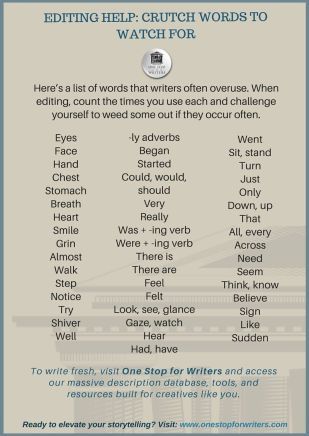 DOWNLOAD
DOWNLOAD7. Get rid of your obvious ���writer tells���
Watch out for random info dumps that slow the read down. Info dumps are also a favourite of amateur writers, so you want to make sure your exposition flows smoothly. Last of all, make sure you identify your crutch words. Crutch words are those ���filler words��� you personally over-use that can be substituted or cut altogether.
8. Sweat the small stuff
So you���ve worked on the big plotting and character stuff holistically ��� Then worked your way down to individual scenes. This means NOW is the time to really work on stuff like grammar, spelling and punctuation. I would also recommend ensuring your draft is free from purple prose, which are those overwritten, ornate chunks of text.
9. Stay positive

At this point, you may feel like your brain is about to explode. You may hate your book and have no idea whether it is good. THIS IS NORMAL and literally happens to all writers, even pro authors. Don���t freak out.
10. Get a beta reader (or two!)
Now you���ve written and revised your novel, it���s time for some feedback. Get a beta reader ��� this is someone who can give you feedback. Find them online in writers��� groups, via hashtags on Twitter and Instagram or at networking events (both on Zoom and real life). Alternatively, there are services where you can pay for specialist readers, though B2W always recommends exhausting your free options first.
Good Luck!
 Lucy V. HaysResident Writing Coach
Lucy V. HaysResident Writing Coach Lucy is a script editor, author and blogger who helps writers at her site, Bang2write.com. To get free stuff for your novel or screenplay, CLICK HERE.��
Twitter �� Facebook �� Instagram
Before you go…
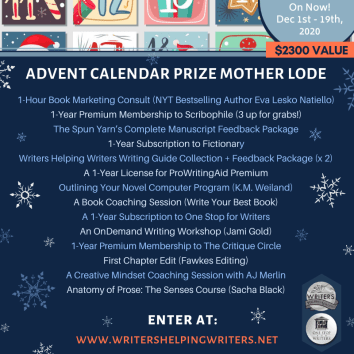
Have you entered the Advent Calendar for Writers Giveaway, yet?
14 giveaways, and $2300 in prizes to be won!
Why not give your career a big boost for 2021?
Enter one or all – the giveaway links are here. And good luck!
The post 10 Steps To Revise Your Nano Novel appeared first on WRITERS HELPING WRITERS��.
December 12, 2020
Relationship Thesaurus Entry: Co-Workers
Successful stories are driven by authentic and interesting characters, so it’s important to craft them carefully. But characters don’t usually exist in a vacuum; throughout the course of your story, they’ll live, work, play, and fight with other cast members. Some of those relationships are positive and supportive, pushing the protagonist to positive growth and helping them achieve their goals. Other relationships do exactly the opposite, derailing your character’s confidence and self-worth or they cause friction and conflict that leads to fallout and disruption. Many relationships hover somewhere in the middle. A balanced story will require a mix of these dynamics.
The purpose of this thesaurus is to encourage you to explore the kinds of relationships that might be good for your story and figure out what each might look like. Think about what a character needs (good and bad), and build a network of connections for him or her that will challenge them, showcase their innermost qualities, and bind readers to their relationship trials and triumphs.
Description:

Dynamics of a Healthy Relationship
Fostering an environment of cooperation
Recognizing the strengths other people bring to the table
Seeing co-workers as part of the team rather than threats or rivals
Respecting the established workplace hierarchy
Making things easier for others and not more difficult (keeping one’s desk neat, cleaning up after a meal in the break room, providing requested materials on time, etc.)
Respecting personal boundaries
Maintaining an attitude of professionalism
Being tolerant of differences
Dynamics of an Unhealthy Relationship
Selfish behaviors (being late to meetings, not following through with responsibilities, letting someone else do the lion’s share of the work, etc.)
Not engaging with or getting to know others
Telling jokes, using language, or touching a co-worker in a way that makes him or her uncomfortable
Always having to get one’s way or have the last word
Sucking up to the boss
Poaching clients or business from a co-worker
Unethical behaviors (stealing supplies, sabotaging a co-worker, making false claims, etc.)
Forming cliques that exclude or ostracize co-workers
Gossiping about co-workers
Treating co-workers as if they are inferiors instead of equals
Conflicting Desires that Can Impair the Relationship
Two co-workers vying for the same position or project
One co-worker wanting what’s best for the company while the other is serving only himself
One co-worker wanting to do his best while the other wants to do the minimum
Co-workers who have different visions/goals for a project or the company as a whole
One co-worker seeking a romantic relationship with another who isn’t interested
A co-worker who wants to have fun on the job being paired with one who is all seriousness
Clashing��Personality Trait��Combinations:
Analytical and Empathetic, Bold and Cautious, Cooperative and Uncooperative, Oversensitive and Tactless, Decisive and Indecisive, Efficient and Flaky, Industrious and Lazy, Organized and Disorganized, Manipulative and Gullible
Negative Outcomes of Friction
Decreased productivity at work
Reprimands (being placed on suspension or given a bad performance review)
The character gaining the reputation of not being a team player
Being denied advancement opportunities at work (not getting a promotion, not being trusted with an important account, etc.)
Friction with a co-worker making things awkward or hostile
Being sabotaged by a co-worker
Employees choosing sides in a rivalry or workplace battle, creating a dysfunctional work environment
The business suffering
Decreased morale among employees
Missing out on opportunities to learn from co-workers whose strengths complement the character’s weaknesses
Scenarios That Could Turn These Characters into Allies
Rival co-workers joining forces to defeat a common enemy from within (a pervy boss, a brown-nosing co-worker on the path to advancement, etc.)
Co-workers having to come together to land a huge account or client
Recognizing that they have something important in common
An opportunity that highlights each person’s strengths, resulting in mutual respect
The company being threatened by a merger or acquisition that would destroy it
A devastating development for a staff member that causes the co-workers to unite so they can bring aid, raise money, or provide relief
One character having to work with someone who is much worse than the co-worker and realizing how good they had it (i.e., not knowing what you’ve got ’til it’s gone)
Ways This Relationship May Lead to Positive Growth
Themes and Symbols��That Can Be Explored through This Relationship
A Fall from Grace, Betrayal, Crossroads, Deception, Greed, Inflexibility, Perseverance, Recognition, Refuge, Rite of Passage, Sacrifice, Stagnation, Teamwork
Other Relationship Thesaurus entries can be found here .
Need More Descriptive Help?

While this thesaurus is still being developed, the rest of our descriptive collection (15 unique thesauri and growing) is accessible through the One Stop for Writers THESAURUS database.
If you like, swing by and check out the��video walkthrough, and then give our��Free Trial��a spin.
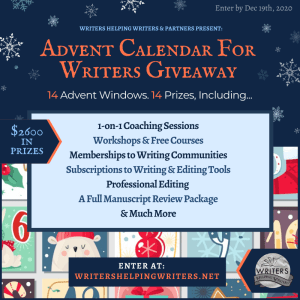
$2300 in Writerly Prizes…Have You Entered Yet?
A heads up that our Advent Calendar for Writers is back and that means a ton of great things you could win to help you with writing, editing, and marketing! Don’t miss this event – enter between December 1 – and 19th, 2020, and good luck!
The post Relationship Thesaurus Entry: Co-Workers appeared first on WRITERS HELPING WRITERS��.
December 9, 2020
Giveaway Alert: The Advent Calendar for Writers ($2300 in Prizes!)
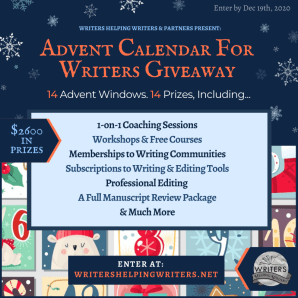
Let’s not beat around the bush: 2020 has been a dumpster fire.
But don’t worry…we’ve got something that will make this year wrap up better than it started: a custom Advent Calendar for Writers!
Even better? It’s loaded up with $2300 in writerly prizes!
Want to try and win something amazing?
Here’s how: Each day between December 1-14th, a new giveaway goes live right here at Writers Helping Writers. To discover what it is and enter, all you have to do is click our Advent Window.

This Advent Window, in fact:
���
That’s right – click it to visit today’s giveaway!
After you enter, go here to find other unlocked giveaways. You can enter every draw until end-of-day December 19th.
14 Days. 14 Amazing Giveaways.
Remember, check back each day until all 14 giveaways are unlocked. Then enter them all, it’s that easy. Good luck, friends!
The post Giveaway Alert: The Advent Calendar for Writers ($2300 in Prizes!) appeared first on WRITERS HELPING WRITERS��.
December 8, 2020
Story Tropes: To Avoid or Not to Avoid?
Every genre and medium of storytelling uses tropes, common themes or story devices. For example, a popular trope in the romance genre is ���enemies to lovers,��� where the characters start as enemies before falling in love.
Most articles we come across in the writing world discuss avoiding tropes. After all, they can be the result of lazy writing and lead to predictability in our stories.
However, tropes aren���t all bad. In fact, we usually can���t avoid including at least a few in our writing. So how can we make tropes work for our story?
Why Can���t We Completely Avoid Tropes?
[image error]
Tropes are some of the building blocks of storytelling. No matter which way we turn with our story���s draft, that choice likely plays into a trope.
For example, let���s say we need to add stakes or an element of character growth to our hero���s motivation before the big showdown at the climax. There���s a good chance that whatever event we choose to enact that change is a trope:
Mentor dying? That���s a trope.Loved one threatened? TropeUltimatum from someone with power? TropeAnd so on���
Stories are made of tropes in the same way that trees are made of wood. We can���t avoid tropes because they���re part of what we use to build our stories.
So Why Does Advice Warn Us about Tropes?
Given that tropes are a normal element of storytelling, why does most advice focus on avoiding them? Like with any aspect of writing, we can fall into lazy habits when it comes to tropes.
Being lazy with the use of tropes means that we end up with a too-predictable story. Or that we���re relying so much on trope formulas that the story itself fails to show rather than tell. In short, a lazy use of tropes can lead to boring, unengaging, and formulaic stories, not to mention disappointed readers.
[image error]
For example, a common trope with sports or team-focused stories is that a group of underdog misfits manages to win an important competition against all the odds. A lazy use of the trope would set up the situation of the underdog misfits, throw in a superficial lesson about them learning to value teamwork, and then expect the reader to buy into their sudden success just because everyone knows that���s how the trope plays out.
In other words, tropes are bad when we as storytellers rely on them to carry the work of the story. Just because readers know an enemies-to-lovers romance story ends with the characters getting together, that doesn���t mean the storyteller can skip out on doing the work to show the audience���and make them believe���the characters have actually overcome their incompatible goals and found common ground.
Some Predictability Is Good
The promises at the heart of each genre���happy-ending romances, solved mysteries, and vanquished thriller villains���help define the genre, so it���s obviously not always bad for readers to know how to fill in the blanks. Similarly, story tropes help readers know what kind of story we���re going to tell, what they can expect on our pages.
So we wouldn���t want to avoid all tropes, even if we could, as tropes are often why readers like a story���they want the type of story that comes with that trope. Many romance readers love the enemies-to-lovers trope so much that they pick up any book with that trope. Personally, I���m a sucker for the fake-dating trope in romance stories.
The trick is finding the right balance to that predictability. Readers want to be able to predict our story enough to know that it will appeal to them. But readers also want their expectations met in a surprising way.
3 Ways to Improve Our Use of Tropes
Think: Similar But Different
To find the right balance of predictability, we can���t just lazily follow a trope���s formula. We need to take the usual trope ideas and play with them. Twist them. Turn them on their head.
The first Iron Man movie took the superhero origin story and twisted it by making the protagonist unworthy of his powers. Rather than being a relatable every-man, Tony Stark was an anti-hero.
Layer Tropes to Create Unique Stories
Stories can be less predictable if we use more tropes. Layering story elements and expectations can make them interact in interesting and surprising ways.
The Worst Best Man��by Mia Sosa layers tons of tropes: office romance (the couple has to work together on a project), forbidden romance (the hero is her ex-fianc�����s brother), enemies-to-lovers (the brother is the one who broke them up���at the altar), fake dating (as they do research for their project), just-one-bed (during said research), and so on. Together, those layers create a unique story with an unpredictable path to the genre���s expected happily ever after.
Focus on Relatability
[image error]
Tropes often make our story more relatable to readers. After all, in real life, we go down to the basement to fix the burned-out lightbulb, no matter how many horror movies we���ve seen. Or even if readers haven���t experienced the trope themselves, the predictability of it can still help create that all-important connection between characters and readers.
That���s why tropes can be a marketing point for our book, letting potential readers know what to expect from our story. We might use our story���s tropes to develop the back-of-the-book blurb. Or we might allude to our story���s tropes in marketing materials.
With the right attitude toward tropes, we can improve our storytelling and appeal to readers. *smile* Do you have any questions or insights about tropes and how to use them?
 Jami GoldResident Writing Coach
Jami GoldResident Writing Coach After muttering writing advice in tongues, Jami decided to put her talent for making up stuff to good use. Fueled by chocolate, she creates writing resources and writes award-winning paranormal romance stories where normal need not apply. Just ask her family���and zombie cat. Find out more about Jami here, hang out with her on social media, or visit her website and Goodreads profile.
Twitter �� Facebook �� Pinterest
Don’t Forget…
[image error]
The Advent Calendar for Writers event is on now!
We have 14 days of giveaways including a workshop with Jami Gold that YOU WANT TO WIN!
You can find all the other unlocked giveaways right here. Good luck…there’s $2300 in prizes to be won!
The post Story Tropes: To Avoid or Not to Avoid? appeared first on WRITERS HELPING WRITERS��.
December 5, 2020
Thoughtful Gifts for Writers
Each year we put together a list of gift ideas for writers – some fun, some functional. This year, let’s face it, writers have struggled more than usual.
So this time around, our list focuses on truly thoughtful and useful gifts you can give to show you support them & their creative goals!
The gift that showcases their hard work.
[image error]
I love this set of Author bookends because most of us know Imposter’s Syndrome a little TOO well. If you are buying for an author, this gift says, BE PROUD OF WHAT YOU’VE ACCOMPLISHED. One book or 100, it doesn’t matter.
There is also a “Writer” one available, but honestly, buy this one for the author-to-be, too because to them it says, I BELIEVE IN YOU.
The gift that respects their need to focus.
[image error]
These days, homes are busier with kiddos and spouses around more often. So when your writer-in-residence needs an escape, noise-cancelling headphones acts as a gateway to their own, distraction-free world.
This headset is highly rated, but there are lots of types and prices, so find something that fits your budget. (Affiliate link)
The gift that thinks about their comfort.
[image error]
Sure, butt cushions aren’t sexy, but you know what is? People who care enough to ensure their favorite writer is comfortable when seated for hours at a time!
This seat cushion comes with a pretty awesome rating so might be a good starting point if you are looking for a gift like this. (I just bought one and my butt is happier.)(Affiliate link)
The gift that alleviates pain and can be a “butt-in-chair” reward.
[image error]
The hunched-over-keyboard lifestyle of a writer can lead to some debilitating headaches as well as neck, shoulder and back pain. And while a masseuse on standby probably isn’t in the budget (sadface) this RESTECK massager probably is. (Affiliate link)
Not only can it be used anywhere on the body, note the pockets for wrists and how it can be used while typing on a keyboard. I think you are picking up what I’m laying down here…this is comfort nirvana.
[image error]
The gift that helps them become a show-don’t-tell Jedi.
Every writer wants to craft a story that captivates, and a big part of doing that is making sure their description is meaningful, pulling readers in and powering the events of every scene.
This writing guide series has sold nearly 600,000 copies worldwide and is consistently recommended by editors, universities, and best-selling authors as a “Writer’s Must-Have.”
The gift that helps them with big picture editing.
[image error]
Fictionary is software that specifically looks at 38 critical elements of storytelling to ensure a WIP (work in progress) has strong bones.
This means a writer can continue to revise and polish with confidence and save money on fees if they choose to engage an editor down the road!
The gift that will help them produce a clean manuscript.
[image error]
ProWritingAid can be a lifesaver to writers seeking to put their best foot forward as they polish and submit their work for consideration or prepare it for publication.
Chances are your writer isn’t a grammar guru but with ProWritingAid, they don’t have to be! Check out PWA’s many features and reports that will help with the heavy lifting of editing.
The gift that inspires.
[image error]
Have you ever received a subscription box gift filled with wonderful things tied to an interest of yours? I have, and it’s amazing! You can send something extra special for the writer in your life by getting them a Writerly Kits Subscription Box.
Find the perfect plan option: a single box to an entire year of treasures arriving at your favorite writer’s doorstep.
The playful gift that says, “I love you who you are.”
[image error]
Everyone loves to be surprised by thoughtfulness, especially writers! The writer’s workspace, their tools, and their favorite writing spaces are key to their identity, so why not immortalize them through a writer-theme caricature?
You can choose the static background pictured here or customize it, it’s up to you!
The gift that is a cherished memento of their biggest dreams.
[image error]
Imagine the writer in your life seeing . The talented Avery Olive designs miniature books with 16 actual pages of the story inside, followed by blank pages to give it scale.
If your writer is pre-published, choose a book from her collection to serve as inspiration for their authorly goals! If they have books under their belt, talk to Avery about designing a custom book ornament. She can do both!
The gift that can help them become a master storyteller.
[image error]
Saving the best for last, One Stop for Writers is what happens when two, out-of-the-box story experts decide to change the writing game.
The One Stop library contains an arsenal of resources, tutorials, and one-of-a-kind tools that demystifies the harder-to-understand writing concepts so your writer can get their imagination onto the page faster and easier, and best of all, strengthen their writing skills as they go. Gift certificates are available for 1-month, 6-month, and 12-month plans.
A peek at what’s waiting at One Stop for Writers:
What’s on your Writerly Wish List this year? Let us know in the comments!
[image error]
Oh, and before you head off to do great writerly things, don’t forget the Advent Calendar for Writers Giveaway is on right now!
That means you can enter to win prizes to help you write, edit, market, and so much more! Head over here to start entering these giveaways valued at an amazing $2300 in total.
The post Thoughtful Gifts for Writers appeared first on WRITERS HELPING WRITERS��.
December 3, 2020
Do You Have a Sense of Where You Are?
I’ve been playing basketball most of my life. When I was a kid, falling in love with the game, I happened across a book called A Sense of Where You Are by John McPhee. It was a profile of Bill Bradley when he was one of the best college hoopsters ever, nearly leading lowly Princeton to the national title.
What impressed me was Bradley’s work ethic. He practiced for hours a day, in all sorts of weather, perfecting his shots, his moves. He even spent considerable time on the classic hook shot, in order to have a complete game.
So the summer between seventh and eighth grade I had my dad put up a basket on our driveway. I practiced every day, sometimes in the rain, sometimes into the night with the driveway lit up by a single floodlight.
[image error]
I got books on basketball technique from the library and taught myself the proper way to shoot a jump shot. I learned you have to keep your elbow in, not flared out. I learned to give the ball a perfect spin. In fact, I became the deadliest shot in the history of Parkman Junior High School. In further fact, I was All League in high school and played a year in college. In furthest fact, had I been a couple inches taller and about five seconds faster, I’d be in the Basketball Hall of Fame.
Larry Bird? Pheh.
But I digress.
One morning a few years ago, I was shooting around a local park when I got into doing some hook shots. Now that’s one shot I worked on a little bit when I was younger, but never really developed into something deadly. My specialty was the 15 – 20 foot jumper, and that’s what I practiced most.
But this day, for some reason, it occurred to me that as I had taught myself the proper way to shoot a jump shot, maybe I ought to take another look at the hook. So I started to experiment with a different release point, looking for another feel. And in about five minutes I happened on a slightly modified shot, but that modification made a huge difference. The hooks started to fall!
I felt like a kid again, with the joy of discovering a new technique that works. After all these years, I had a stronger hook shot with only a few adjustments.
I bring this up because I get this feeling as a writer, too. I still get excited when I put a new spin on a technique and it works. That’s why I continue to read books on writing, Writer’s Digest magazine, blogs, and lots and lots of novels, seeing what works, trying stuff out. My philosophy is if I learn just one thing, or get a new view on something I already know, it’s worth it.
Don’t ever think you have arrived. When you think that, even if you’re multi-published, you start to atrophy. There are authors who once cared about the craft but now just mail it in, because they have an established following.
Don’t let that be you. Respect the craft, and keep at it.
In his book, McPhee described Bill Bradley’s ability to throw up a shot with his back to the basket ��� no look ��� and make it most of the time. When he asked Bradley how he could do that, Bradley replied, “You develop a sense of where you are.”
Know where you are, writer, and how you can get better. Then practice. That’s really the secret to succeeding as a writer. Maybe the only secret: practice ������ day after week after year. But practice with a purpose.
1. Rate yourself in each of the critical success factors of fiction: plot, structure, characters, scenes, dialogue, voice, meaning (theme).
2. Make it your goal to improve by 10% in each area you listed. Give yourself a deadline to do this.
3. Spend a good part of each day or week to read writing books and blog articles that cover the areas you���re improving. Be sure to include practice writing based on what you���ve learned.
You���ll be most pleased with the results. So will your readers.
 James Scott BellResident Writing Coach
James Scott BellResident Writing Coach Jim is the author of the #1 bestseller for writers, Plot & Structure, and numerous thrillers, including Romeo���s Rules, Try Dying and Don’t Leave Me. His popular books on fiction craft can be found here. His thrillers have been called “heart-whamming” (Publishers Weekly) and can be browsed here. Find out more about Jim on our Resident Writing Coach page, and connect with him on
Twitter
[image error]
$2300 in Writerly Prizes…Have You Entered Yet?
A heads up that our Advent Calendar for Writers is back and that means a ton of great things you could win to help you with writing, editing, and marketing! Don’t miss this event – enter between December 1 – and 19th, 2020, and good luck!
The post Do You Have a Sense of Where You Are? appeared first on WRITERS HELPING WRITERS��.
November 30, 2020
The Advent Calendar for Writers Is On Now!
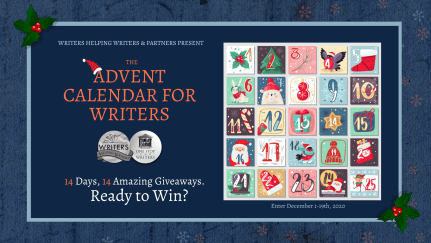
Writers all across the globe look forward to this annual event – the biggest and best writing giveaway around: The Advent Calendar for Writers.
What exactly is an Advent Calendar for Writers?
You know those Advent Calendars with delicious chocolate behind each window, counting down to Christmas? Well, it’s like that, only cooler. MUCH COOLER.
($2300-worth-of-prizes cooler.)
Fact: 2020 has NOT been a great year, but 14 industry leaders have come together to make sure it ends much better than it started! These generous sponsors are offering up INCREDIBLE PRIZES to ensure you have an adrenaline-fueled December, and maybe win yourself something awesome.
From December 1st to December 14th, a new Giveaway is unlocked.
What can you win? Check it out:
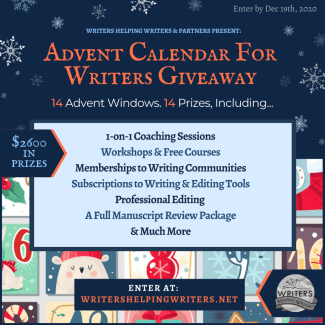
So…ready to find out what you might win in today’s draw?

See this Advent Window?
���
Click it to visit Day 14’s giveaway!
14 Days. 14 Amazing prizes with a combined value of over $2300.
Now that all the giveaways are unlocked, follow the links below to enter them all by December 19th!
Dec 1: A Marketing Consult with NYT Best-Selling Author Eva Lesko Natieillo
Dec 2: A 1-Year Subscription to Fictionary Storyteller
Dec 3: A First Chapter Edit by Fawkes Editing
Dec 4: A Complete Manuscript Feedback Package by The Spun Yarn
Dec 5: An OnDemand Writing Workshop with Jami Gold
Dec 6: A 1-Year License for ProWritingAid Premium
Dec 7: A 1-Year Subscription to One Stop for Writers
Dec 8: A Seat in Anatomy of Prose: The Senses Course
Dec 9: A 1-Hour Coaching Session with Christina Kaye
Dec 10: A One-on-One Mindset Wellness Coaching Session with A.J. Merlin
Dec 11: One Year Premium Membership to Scribophile
Dec 12: An 8-book Thesaurus Collection + Story Feedback from Becca & Angela
Dec 13: Outlining Your Novel Workbook Program (K.M.Weiland)
Dec 14: A Premium Membership to The Critique Circle
Enter by December 19th. Winners will be drawn on the 20th.

Huge gratitude to the kind contributors involved in this giveaway.
As you enter these draws, take a moment to get to know the people and businesses behind them. Everyone involved has a big heart for writers, and a product or service to help you reach your writing goals.
Why not share this giveaway with the writers you know? And good luck to all!
The post The Advent Calendar for Writers Is On Now! appeared first on WRITERS HELPING WRITERS��.
The Advent Calendar for Writers Starts Now!
Writers all across the globe look forward to this annual event – the biggest and best writing giveaway around: The Advent Calendar for Writers.
What exactly is an Advent Calendar for Writers?
You know those Advent Calendars with delicious chocolate behind each window, counting down to Christmas? Well, it’s like that, only cooler. MUCH COOLER.
($2300-worth-of-prizes cooler.)
Fact: 2020 has NOT been a great year, but 14 industry leaders have come together to make sure it ends much better than it started! These generous sponsors are offering up INCREDIBLE PRIZES to ensure you have an adrenaline-fueled December, and maybe win yourself something awesome.
From December 1st to December 14th, we will display an Advent Calendar Window for you to click. This mysterious portal will take you to a NEW giveaway each day!
What sort of things might you find behind the advent window? Well maybe stuff like this:
[image error]
So…ready to find out what you might win in today’s draw?
[image error]
See this Advent Window?
���
Click it to discover today’s giveaway!
14 Days. 14 Amazing prizes with a combined value of over $2300:
Dec 1: Something authors need (valued at $200)
Dec 2: Something to help you improve a novel (valued at $200)
Dec 3: Something every writer needs (valued at $115)
Dec 4: Something that will blow your mind (valued at $500)
Dec 5: Something you’ll get huge value from (valued at $80)
Dec 6: Something to make editing much easier (valued at $80)
Dec 7: Something to change the storytelling game (valued at $90)
Dec 8: Something to help your descriptive skills (valued at $130)
Dec 9: Something every writer wants (valued at $250)
Dec 10: Something to help you focus on success (valued at $130)
Dec 11: Something to connect you more (value $65 x 3 winners)
Dec 12: Something to strengthen your writing ($140 x 2 winners)
Dec 13: Something to help you start a book off right (valued at $40)
Dec 14: Something to speed learning (valued at $50 x 2 winners)
This event runs from Dec 1st to the 19th. Winners will be drawn on the 20th.
[image error]
Huge gratitude to the kind contributors involved in this giveaway.
As you enter these draws, take a moment to get to know the people and businesses behind them. Everyone involved has a big heart for writers, and a product or service to help you reach your writing goals.
Don’t forget: check back each day to see what new Advent giveaway is waiting for you!
Why not share this giveaway with the writers you know? And good luck to all!
The post The Advent Calendar for Writers Starts Now! appeared first on WRITERS HELPING WRITERS��.
November 26, 2020
Master Storytelling and Save: One Stop for Writers is 50% Off
Well, Black Friday is here and keyboards everywhere are heating up. I wish you a successful day of bargain hunting!
[image error]
While you’re out there taking advantage of the sales, consider one that can vastly help improve your writing: a One Stop for Writers subscription.
Right now you can score a 6-month subscription for 50% off. (Holy gluten free bananas, that’s only $25!)
So, if you need access to:
The largest, show-don’t-tell description database in existencePowerful Story Map, Scene Map, and Timeline toolsCustomizable Worldbuilding SurveysAn Idea Generator Templates, Worksheets, Checklists, and TutorialsAnd a Character Builder tool so smart it will create an accurate Character Arc Blueprint for any character you design (Yes, really!)
Visit One Stop for Writers and add the one-time code BLACKFRIDAY2020 when you subscribe to the 6-month plan.
Becca and I would love to help you write fantastic, memorable fiction. Writing can be easier with the right tools in your creative toolkit!
ONE STOP FOR WRITERS
This deal disappears November 30th, 2020. See you at One Stop for Writers!
The post Master Storytelling and Save: One Stop for Writers is 50% Off appeared first on WRITERS HELPING WRITERS��.
November 25, 2020
How Stakes Set up Expectations
Last time I coached on Writers Helping Writers, I talked about 6 Tricks to Layer on Stakes, in it, I explained how I like to think of stakes as potential consequences–what could happen if a certain condition is (or is not) met. For stakes to be most effective, they usually need to be specific and often on the page. They should follow a cause-and-effect trajectory.
Usually, we want more stakes on the page than what actually comes to pass.
One thing that stakes do, is they set up the reader’s expectations. They may not always be 100% solid expectations, but they set up expectations more or less.
[image error]
Because if Suzy accidentally left her campfire going, then I would expect that it could start a forest fire. That is a logical outcome. Depending on how this is rendered in the story and what’s happening in the plot, and what I, the reader, have read and seen in other stories before, I may fully expect that to happen next: Suzy’s campfire will start a forest fire.
Now that my expectations are set up, the author can play with them, if he or she desires.
Stakes are what might happen, not necessarily what actually happens. When you set them up as a writer, you have a few options on how to handle the actual outcome.
The situation leads to the expected problem:
Suzy’s campfire does start a forest fire.
The situation leads to no problems:
2. The campfire peacefully burns out, and it rains that night.
The situation leads to a problem worse or bigger than expected:
[image error]
3. The campfire not only starts a forest fire, but burns up a few homes, and the state park.
The situation leads to a surprising outcome:
4. The campfire attracts a bigfoot.
Good writers will take advantage of these different outcomes (whether the writer is fully conscious of doing that or not).
Be careful of using option 2: The situation leads to no problems. If you use that too much, you run the risk of undercutting the tension in your story. This is when the writer cuts threads of tension, so that there is no tension in the story for a period of time, or when the writer repeatedly fails to deliver on promised conflict.
The point is, when you work with stakes, you set up expectations in the audience. This is a good thing, because it helps the audience get invested in the story (unless you are only setting up expectations that are totally predictable). Once they have expectations, they’ll want to stick around. And you, the writer, can meet them, surprise them, or over-deliver on them. And yes, sometimes, undermine them too (only on occasion, and only when you have plenty of other important forms of stakes and tension in play).
So think about what your audience is expecting from your story’s stakes. And if you are only using one or two of these types of outcomes, try to switch it up to keep your readers surprised.
 September C. FawkesResident Writing Coach
September C. FawkesResident Writing Coach September C. Fawkes has worked as an assistant to a��New York Times��bestselling author and writing instructor, and now does freelance editing at FawkesEditing.com. She has published poetry, short fiction, and nonfiction articles, and her award-winning writing tips have appeared in classrooms, conferences, and on Grammar Girl. Visit her at SeptemberCFawkes.com for more writing tips, and find her on
Twitter �� Facebook �� Instagram �� Tumblr
Need more ideas? Download this Tip Sheet on Raising the Stakes from One Stop for Writers:
[image error]
[image error]
Savings are nice, right?
We’ve hunted high and low for great “Writing-Related” Black Friday deals and found quite a few items!
To see all the things on sale right now, just head over here.
The post How Stakes Set up Expectations appeared first on WRITERS HELPING WRITERS��.
Writers Helping Writers
- Angela Ackerman's profile
- 1014 followers



